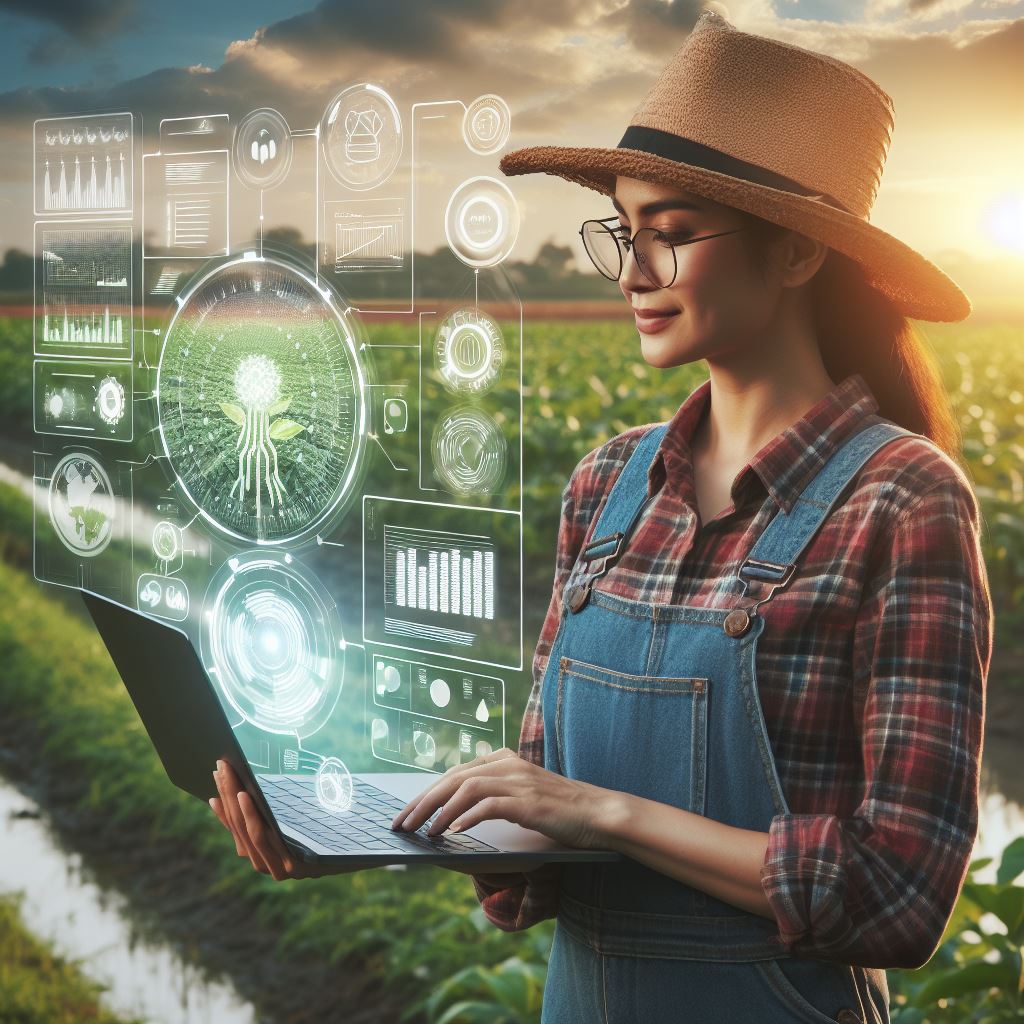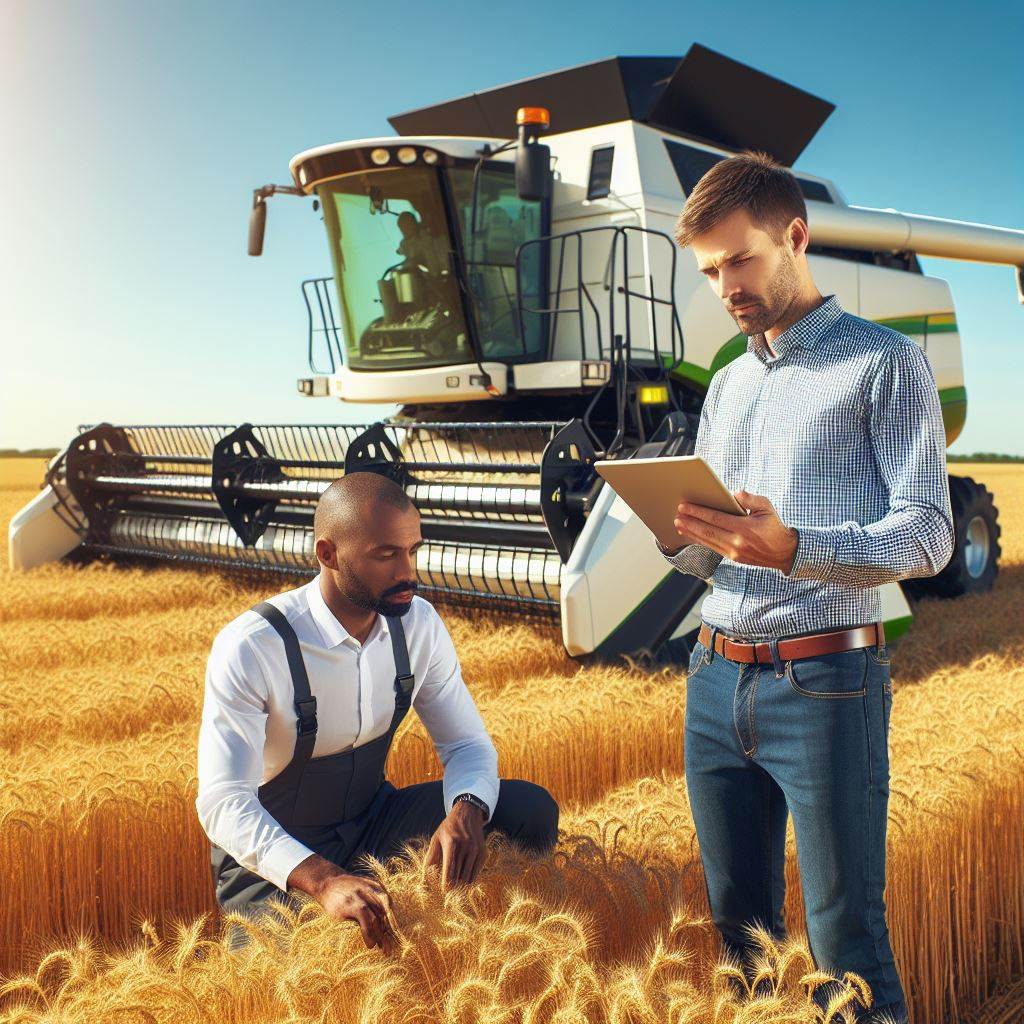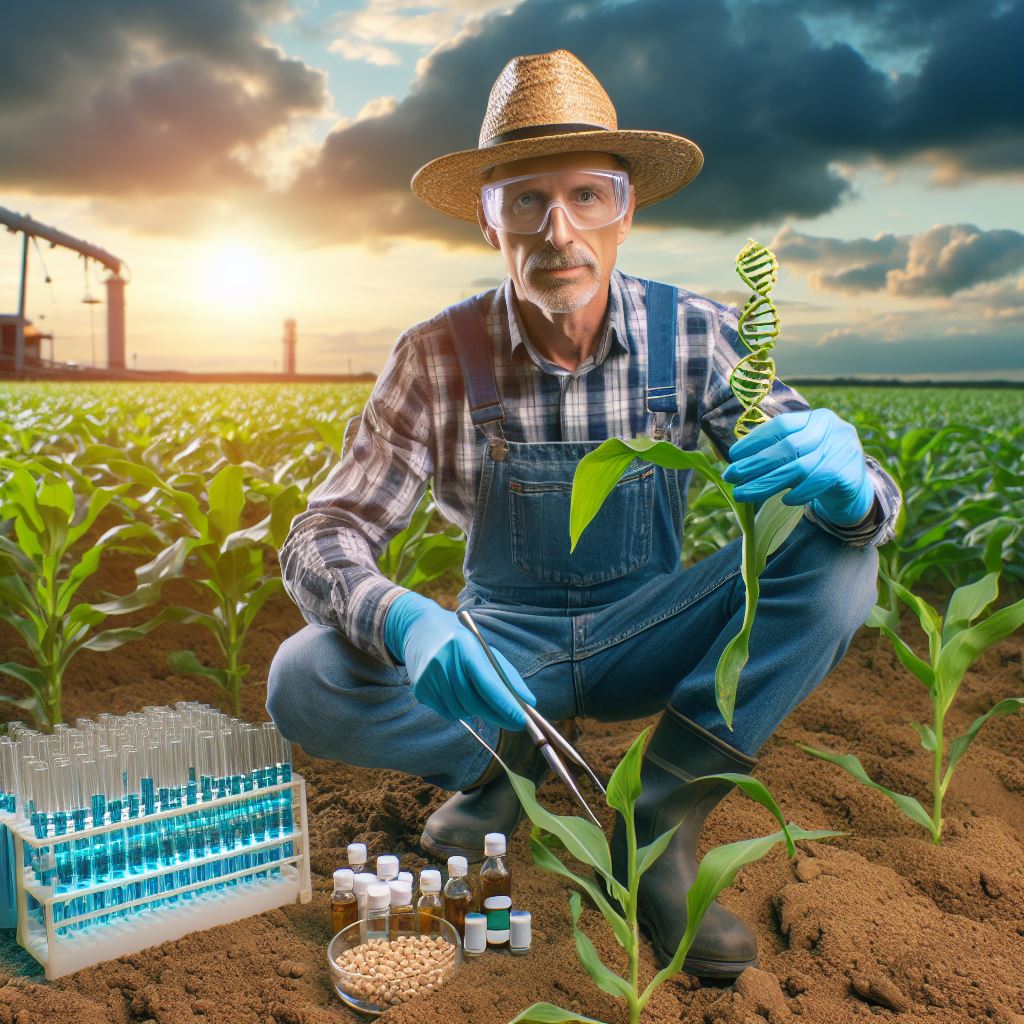Introduction
Definition of big data in agriculture
In the world of agriculture, big data is playing a transformative role.
Big data refers to the massive amounts of information that can be collected and analyzed to gain insights and make informed decisions.
It encompasses data from various sources such as sensors, drones, satellites, and weather stations.
Importance of big data in modern agriculture
The importance of big data in modern agriculture cannot be overstated.
It allows farmers to optimize their operations, enhance productivity, and reduce costs.
By analyzing data on soil conditions, weather patterns, and crop health, farmers can make more accurate decisions on when and how to plant, fertilize, and irrigate crops.
This leads to increased yields and reduced waste.
Additionally, big data enables precision agriculture techniques, such as variable rate application and site-specific management.
With the help of sensors and GPS technology, farmers can customize their approach to each area of their land, applying the right amount of inputs only where needed.
This not only saves resources but also minimizes the environmental impact of farming practices.
Big data is transforming agriculture and driving innovation in farming practices
Basically, big data is transforming agriculture and driving innovation in farming practices.
The ability to collect, analyze, and interpret vast amounts of data enables farmers to make data-driven decisions and optimize their operations.
This results in increased efficiency, improved productivity, and more sustainable farming practices.
As technology continues to advance, the role of big data in agriculture is only expected to grow further.
Role of sensors and IoT in collecting data
In the era of big data, sensors and the Internet of Things (IoT) play a crucial role in transforming agriculture.
Transform Your Agribusiness
Unlock your farm's potential with expert advice tailored to your needs. Get actionable steps that drive real results.
Get StartedThese technologies enable farmers to collect vast amounts of data, providing valuable insights for decision-making and optimizing agricultural practices.
Sensors and their applications in agriculture
Sensors are devices that detect and measure changes in physical, chemical, or biological conditions.
In agriculture, sensors are used extensively to monitor various parameters that influence crop growth and health.
They provide real-time data, facilitating precision agriculture and resource management.
In this context, here are some notable applications of sensors in agriculture:
- Weather monitoring: Sensors measure temperature, humidity, wind speed, and rainfall, allowing farmers to predict weather patterns and take appropriate actions to protect crops.
- Soil moisture levels: Sensors help assess soil moisture, enabling farmers to optimize irrigation practices and prevent under or over-watering.
- Plant growth and nutrient levels: Sensors monitor plant health, growth, and nutrient levels, aiding farmers in adjusting fertilization plans and detecting nutrient deficiencies.
- Pest and disease detection: Sensors detect early signs of pest infestations and disease outbreaks, allowing for timely interventions and reducing crop losses.
Examples of data collected through sensors
By using sensors and IoT, farmers can collect a vast amount of valuable data. Some examples include:
- Real-time weather data: Sensors provide accurate and up-to-date weather information, helping farmers make informed decisions on when to plant, irrigate, or harvest.
- Soil moisture data: Sensors measure soil moisture levels, enabling farmers to implement precise irrigation techniques and prevent water wastage.
- Pest and disease monitoring data: Sensors detect signs of pests or diseases, allowing farmers to employ targeted treatment measures, minimizing crop damage and reducing the use of pesticides.
- Yield prediction data: Sensors can estimate crop yield based on factors such as weather conditions, soil health, and plant growth, assisting farmers in planning harvest and marketing strategies.
How IoT enables real-time data collection and analysis
The Internet of Things (IoT) connects sensors and agricultural equipment, allowing seamless data collection and analysis in real-time.
Here’s how it works:
- Data gathering: Sensors collect data on various parameters like weather, soil moisture, and plant health.
- Data transmission: IoT devices transmit the collected data wirelessly to a central data repository or cloud platform.
- Data storage and processing: The collected data is stored and processed using advanced analytics tools, enabling farmers to derive meaningful insights.
- Real-time analysis: Farmers can access the analyzed data in real-time through web-based or mobile applications, allowing prompt decision-making.
- Automation and control: The IoT also enables farmers to automate irrigation systems, nutrient delivery, and pest control, based on real-time data analysis.
Generally, sensors and IoT have revolutionized agriculture by enabling data-driven decision-making, optimizing resource utilization, and increasing overall productivity.
As the world’s population continues to grow, harnessing the power of big data is crucial for sustainable and efficient agriculture.
Read: Big Data’s Role in Future Farming
Applications of big data in crop management
Big data is revolutionizing the agriculture industry, transforming the way crops are managed and yielding numerous benefits.
Let’s explore some of the key applications of big data in crop management:
Predictive analysis for crop disease detection and prevention
By analyzing vast amounts of data such as weather patterns, soil conditions, and historical disease outbreaks, farmers can predict and prevent crop diseases more effectively.
This enables them to take proactive measures and mitigate potential losses.
Utilizing historical data to optimize planting and harvest decisions
Big data allows farmers to leverage historical data to make informed decisions about planting and harvest timings.
By analyzing factors like temperature, rainfall, and soil conditions from the past, farmers can optimize their planting schedules for better crop yield and harvest quality.
Intelligent irrigation systems based on weather and soil conditions
With the help of big data, farmers can optimize their irrigation systems based on real-time weather and soil data.
By analyzing this information, they can determine the optimal amount of water needed for crops, reducing water wastage and ensuring efficient use of resources.
Moreover, big data can provide insights into soil moisture levels, allowing farmers to detect areas that require additional irrigation or drainage measures.
Precision agriculture and yield optimization
Big data facilitates precision agriculture, where farmers can use data-driven insights to optimize their farming practices.
By integrating data from various sources such as satellite imagery, drone surveys, and sensors, farmers can monitor crop growth, identify problem areas, and apply targeted solutions only where necessary.
This not only reduces costs and resources but also increases overall crop yield and quality.
By using big data, farmers can achieve better soil health, efficient fertilizer usage, and improved pest management strategies.
Showcase Your Farming Business
Publish your professional farming services profile on our blog for a one-time fee of $200 and reach a dedicated audience of farmers and agribusiness owners.
Publish Your ProfileEssentially, big data is transforming agriculture by providing farmers with powerful tools to optimize crop management.
Whether it’s predicting and preventing crop diseases, optimizing irrigation systems, leveraging historical data for better decision-making, or implementing precision agriculture, big data is revolutionizing the industry.
By harnessing the potential of big data, farmers can not only increase their crop yield and profitability but also minimize resource wastage, mitigate climate-related risks, and build a sustainable future for agriculture.
Read: Agri-Tech and Big Data: Transforming Farm Management
Use of big data in livestock management
Big data has revolutionized several industries, and agriculture is no exception.
The ability to gather and analyze large amounts of data has opened up new possibilities for improving livestock management, animal health monitoring, disease prevention, and productivity through data-driven feeding and breeding practices.
This blog section explores the various applications of big data in agriculture.
Use of Big Data in Livestock Management
The use of big data in livestock management has significantly transformed the way farmers handle their animals.
By collecting and analyzing data from various sources, farmers can make better-informed decisions and improve their overall productivity.
Monitoring Animal Health through Wearable Devices and Sensors
One of the most significant benefits of big data in agriculture is the ability to monitor animal health in real-time using wearable devices and sensors.
These devices can collect data on vital signs, activity levels, and movement patterns, providing valuable insights into the animals’ well-being.
Analyzing Data to Detect Patterns and Prevent Diseases
Big data analytics allows farmers to detect patterns and identify potential disease outbreaks early on.
By analyzing data from multiple sources, such as weather patterns, animal behavior, and health records, farmers can accurately predict and prevent diseases, saving both time and money.
Data-Driven Feeding and Breeding Practices for Improved Productivity
Data-driven feeding and breeding practices have proven to be a game-changer in agriculture.
By analyzing data on animal nutrition, genetic traits, and performance records, farmers can optimize their feeding strategies to ensure healthier and more productive livestock.
Challenges and Future Prospects
While big data offers significant advantages in agriculture, there are also challenges to overcome.
Farmers need to have access to reliable connectivity and the necessary infrastructure to collect and process data effectively.
Moreover, data privacy and security concerns need to be addressed to ensure that farmers’ and consumers’ information is safeguarded.
However, the future prospects of big data in agriculture are promising.
As technology advances and data collection methods improve, farmers will have access to even more accurate and real-time information.
This will enable them to make data-driven decisions in various aspects of farming, leading to increased productivity, reduced costs, and more sustainable practices.
Big data is transforming agriculture by providing farmers with valuable insights into livestock management, disease prevention, and improved productivity through data-driven practices.
With the right infrastructure and data analysis tools, farmers can harness the power of big data to revolutionize the way they farm and contribute to a more sustainable and efficient agriculture industry.
Read: Data-Driven Farming: A Closer Look

Find Out More: Smart Farming: The Rise of Agri Robots
Big Data in Supply Chain Management
Supply chain management plays a crucial role in the success of any industry, including agriculture.
With the advent of big data analytics, the agricultural supply chain has witnessed a revolutionary transformation.
In this section, we will explore how big data is being used to optimize supply chain operations and ensure a seamless flow of goods from farm to table.
Tracking and optimizing inventory levels based on data analytics
With the help of big data, farmers and suppliers can accurately track inventory levels and make data-driven decisions to optimize them.
By analyzing past sales data, weather patterns, and consumer preferences, farmers can predict demand and adjust their inventory accordingly.
This prevents wastage and ensures a steady supply of fresh produce.
Ensuring quality control throughout the supply chain
Big data analytics enables real-time monitoring of various parameters that affect product quality.
From tracking temperature and humidity levels during transportation to analyzing sensor data from farming equipment, every step of the supply chain can be monitored and controlled.
This ensures that only high-quality products reach the market, reducing the risk of recalls and preserving consumer trust.
Enhancing logistics and delivery routes for efficiency
Efficient logistics and delivery routes are crucial to the timely delivery of agricultural products.
Big data analytics allows farmers and suppliers to optimize transportation routes, considering factors like traffic patterns, weather conditions, and delivery schedules.
By reducing transit times and minimizing fuel consumption, the supply chain becomes more sustainable and cost-effective.
Predictive maintenance for machinery and equipment
Agriculture heavily relies on machinery and equipment, such as tractors, harvesters, and irrigation systems.
Big data analytics can predict potential failures or breakdowns, allowing for timely maintenance and reducing downtime.
This proactive approach ensures smooth operations and minimizes productivity losses.
Showcase Your Farming Business
Publish your professional farming services profile on our blog for a one-time fee of $200 and reach a dedicated audience of farmers and agribusiness owners.
Publish Your ProfileReal-time data sharing and collaboration
Big data enables seamless data sharing and collaboration across different stages of the supply chain.
Farmers, suppliers, distributors, and retailers can access and analyze real-time data, fostering effective communication and decision-making.
This improves coordination and allows stakeholders to respond quickly to market demands and changes.
Enhancing sustainability and eco-friendly practices
One of the key benefits of big data in agriculture is its potential to enhance sustainability.
By analyzing environmental data, farmers can make informed decisions on water usage, fertilizer application, and crop rotation.
This reduces the environmental impact of farming practices while increasing productivity and ensuring long-term sustainability.
Minimizing food waste and improving traceability
With big data analytics, the agricultural supply chain can minimize food waste by accurately predicting demand and optimizing inventory levels.
Additionally, traceability becomes more efficient, allowing for quick recall of products in case of contamination or quality issues.
This enhances food safety and builds consumer confidence in the supply chain.
In general, big data is revolutionizing supply chain management in agriculture.
From optimizing inventory levels and ensuring quality control to enhancing logistics and improving sustainability, the impact of big data is undeniable.
By harnessing the power of data analytics, farmers, suppliers, and other stakeholders can streamline operations, reduce costs, and meet the ever-changing demands of the market.
As the agricultural industry continues to evolve, embracing big data will be essential for its growth and success.
Read: Data Analytics in Modern Farming
Challenges and Concerns Related to Big Data in Agriculture
In recent years, big data has been transforming various industries, and agriculture is no exception.
The integration of data analytics and advanced technologies has the potential to revolutionize how we produce food and manage agricultural systems.
However, this transformation is not without its challenges and concerns.
In this section, we will explore some of the key issues related to big data in agriculture.
Privacy and Data Security Risks
- One of the major concerns associated with big data in agriculture is privacy.
- As farmers collect and share large amounts of data, there is a risk of personal information being exposed.
- This includes sensitive data such as financial records, crop yields, and even livestock information.
- Furthermore, data breaches and cyberattacks can jeopardize the integrity and security of agricultural systems.
- A proactive approach to data security measures and privacy regulations is critical to address these risks.
Integration of Various Data Sources and Formats
- Another challenge faced in the realm of big data in agriculture is the integration of different data sources.
- Farmers often rely on multiple systems and platforms to collect data about their operations.
- These sources may include weather sensors, satellite imagery, drones, and even mobile applications.
- The challenge lies in consolidating and standardizing data from these diverse sources.
- Efforts are underway to develop interoperable data formats and protocols for seamless integration.
Access to Technology and Infrastructure in Rural Areas
- Access to technology and robust infrastructure remains a significant concern in rural agricultural areas.
- Many farms lack reliable internet connectivity, hindering the implementation of big data solutions.
- This digital divide prevents farmers from harnessing the full potential of data-driven tools and technologies.
- Investments in rural broadband infrastructure and affordable access to technology are essential.
- Efforts must be made to bridge this divide and ensure equitable access to digital resources for all farmers.
In essence, while big data offers immense potential in transforming agriculture, certain challenges and concerns need to be addressed.
Privacy and data security risks, the integration of various data sources, and limited access to technology and infrastructure are among the key issues.
By proactively tackling these challenges, we can fully harness the power of big data to improve productivity, sustainability, and profitability in the agricultural sector.
Conclusion
Recap of the transformative power of big data in agriculture
The transformative power of big data in agriculture cannot be overstated.
It has revolutionized the way farmers approach their practices and has the potential to drive even greater advancements in the future.
The recap of the transformative power of big data in agriculture highlights its ability to provide valuable insights and improve decision-making.
Through data analytics, farmers can now make informed choices based on accurate predictions and trends.
Encouragement for farmers to embrace data-driven farming practices
Encouraging farmers to embrace data-driven farming practices is essential.
The integration of big data allows for increased efficiency, productivity, and sustainability in agriculture.
By utilizing data, farmers can optimize crop yields, reduce resource waste, and mitigate risks more effectively.
Future potential and advancements in the field of big data in agriculture
Looking towards the future, advancements in big data in agriculture are promising.
Emerging technologies such as precision agriculture, Internet of Things (IoT), and sensor networks offer even more opportunities for data collection and analysis.
These advancements will further enhance the precision and effectiveness of farming practices.
In a nutshell, the use of big data in agriculture has transformed the industry, empowering farmers with valuable insights and driving improvements in productivity and sustainability.
Embracing data-driven farming practices is crucial for farmers to leverage the full potential of big data.
With continued advancements, the future holds even greater possibilities for the application of big data in agriculture, paving the way for more efficient and sustainable food production.




